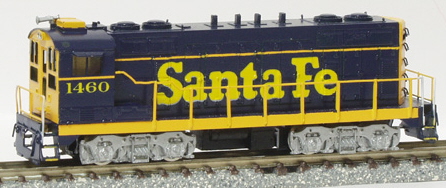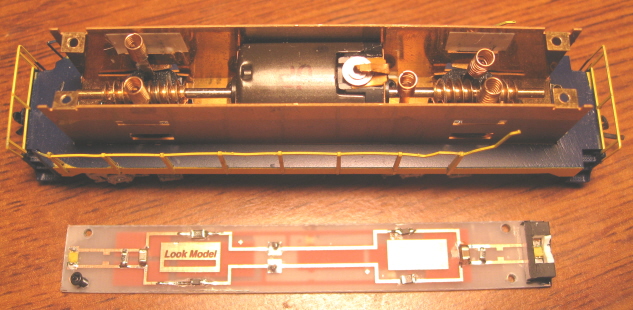

Introduced: circa 2007
I'm told that Look Model is/was a small "Mom & Pop" style operation (or maybe just "Pop") run out of Japan. As of this 2018 writing the Look Model website seems to have vanished, so perhaps Ken is no longer in business.
Anyway, this is an interesting model of an interesting prototype. Unfortunately, I don't think it really measures up to its $200 pricetag. No, it's not quite "amateur hour". But sad to say, it's awfully darned close...

The design is unlike anything I've ever seen before, basically consisting of three light pieces of brass - the shell, the sidesill/handrail assembly, and a flimsy little "box" that holds the motor. And I have no idea what kind of motor it might be as I'm a bit afraid to take the thing apart any further than I already have. Closed-sided? Open-sided? Poles? Winding? Gad, who knows? I will say that based on the extremely high top-end speed, it's most likely a 3-poler. Anyway, pickup is provided by seven of the eight wheels (the remaining wheel being equipped with a traction tire). The axles rub against stiff brass plates, atop of which perch lengthy springs that transfer current to a PC board screwed to the top of the "box". Said PC board provides directional LED lighting. Current flows from the PCB to the motor via more metal contacts (a short contact to the top of the motor, and a long, spring-equipped contact to the bottom of the motor). The motor has dual driveshafts with really long brass worms (turning plastic worm gears inside the two plastic truck towers). All of the truck gearing is plastic. The wheels are low-profile, so no problems on Code-55 rails. Micro-Trains couplers come pre-installed on the sidesill. The truck sideframes are a flimsy assembly of resin castings (loosely CA'd together). Similarly, the fuel tank is a resin casting glued to the bottom of the chassis.
Performance is wholly unimpressive. Mine doesn't seem to want to maintain any sort of constant speed, overall throttle response is fairly uneven, and out-and-out stalls are pretty common. Worse still, the thing wobbles like it's had one too many Jello-shots. Worse worse still, it's barbershop razor loud. And if all that weren't bad enough, mine came with the most out-of-gauge wheelsets I've ever seen on a locomotive - I mean like a couple of millimeters too narrow. Not bad enough yet? Said wheels are so tightly affixed to the axles that you actually have to dismantle the trucks, pull the axles out and attack both wheels with a couple of pliers in order to adjust their gauge back to some semblance of normality. Yeesh!
OK, so they don't run all that great. But, how about the looks? Well, y'know what? Not all that great either. Yes, the shell detailing is very nicely done. But on the paint front, the yellow striping and the large "Santa Fe" logos both look a bit iffy to my eye. Again, not "amateur hour" iffy. But certainly too thinly applied and too "broken" looking to be worthy of a $200 brass locomotive.
So, yeah, it's a neat prototype that's unlikely to ever be replicated elsewhere in N scale. But does all of this "Mom & Pop" style workmanship really merit a $200 pricetag? I guess that'd be up to the individual modeler to decide, but since I've spent most of this review harping about how overpriced it seems, it's pretty obvious that I don't think so.
I guess if I were to suddenly (and inexplicably) find myself desperately wanting to run a "Beep", the first thing I'd do is dump the Look mechanism and see about remounting the shell on something else (for example, an Atlas MP-15 chassis looks like it might be a decent fit).
On a side note, I got the impression somewhere along the line that these models are also available with preinstalled decoders. However, when I purchased mine I was not offered that option (and I forgot to ask about it). So, I dunno. Maybe they are and maybe they aren't. However, given the PC Board situation, I imagine that replacing it in favor of a decoder would be a pretty simple operation (assuming you can find one that has all the contacts in the right places).
Trivia - this locomotive's nickname ("Beep") derives from the fact that it's a Baldwin switcher repowered with EMD "Geep" guts (a one-off experiment at the Santa Fe shops back in 1970).
To remove the shell, unscrew the two small screws on either side of the coupler on the cab end of the locomotive. The shell should slide up and off readily at that point.
Grade: D (and I guess maybe "C" if you can successfully deal with the out-of-gauge wheelsets and the crappy resin truck assemblies)